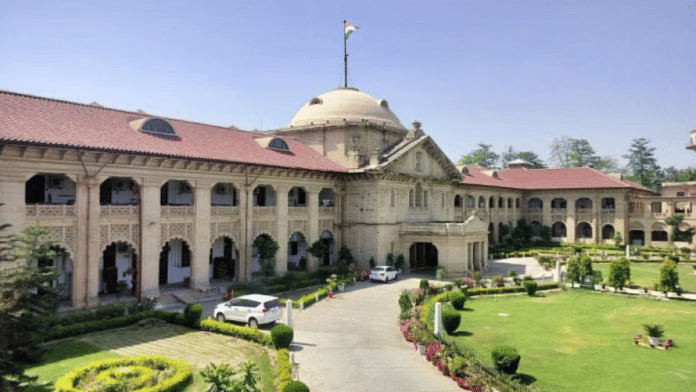New Delhi: The Uttar Pradesh government released a notification Sunday to prohibit mentions of caste of suspects in police stations, and caste references on signboards and vehicles, in response to a 16 September Allahabad High Court order, directing the state to regulate the glorification of caste and end caste discrimination.
The 21 September UP government notification disallowed displays of caste in UP Police records, FIRs, and arrest memos, and also, directed the removal of a column to fill in the caste of the accused from the police portal—Crime and Criminal Tracking Network and Systems. The rule applies in all cases, except the crimes against Scheduled Castes or Scheduled Tribes, where the caste will be recorded.
The notification also introduced strict measures to ensure no boards displaying caste are erected or installed in the future, after a bench of Justice Vinod Diwakar at Allahabad HC directed a competent authority to frame a formal regulation to that effect at the earliest.
In this report, ThePrint explains the case in court that started it all, the HC directions, and the UP government notification.
Case that led to the notification
The UP government notification rose from the Allahabad HC decision, while hearing a plea of an alleged liquor smuggler, caught while in a Black Scorpio car in April 2023, carrying 70 bottles of Royal Challenge Classic Premium Whisky and 36 bottles of Royal Stag Premium Whisky—all for sale in Haryana—but instead on the way to Bihar, where they sell at higher rates.
The accused approached the HC to set aside the criminal proceedings against him, arguing that malintent inspired the case. However, the court denied him relief, noting that another case against him already existed. He ended up in custody for alleged smuggling.
Rejecting that the case had malintent, the court said, “In light of the material on record, it also cannot be held that the impugned criminal proceedings are manifestly tainted with malafide, or maliciously instituted, with an ulterior motive to wreak vengeance on the applicant, or to settle a personal or private grudge.”
Moreover, the number plate affixed to his vehicle was fake, while the real one remained hidden in the boot, the court noted, in a 28-page ruling.
Despite not quashing the criminal case against accused Praveen Chetri—allegedly a gangster—the court noted in its judgment that the investigating officer announced the castes of the suspects, for instance, Mali, Thakur, and Pahadi Rajput, along with names.
The court then passed an order in March this year, directing the Director General of Police (DGP) to file a personal affidavit, justifying the relevance of mentioning the caste of a suspect or a group in the FIR. The court questioned such mentions during a police investigation in a society where social divisions heavily influence law enforcement practices and public perception.
Also Read: DNA tests by botanist, a ‘confession’ & a missing witness—2 acquitted by SC in minor’s rape-murder
Caste question & DGP’s explanation
In response to the court, the DGP of UP Police gave three justifications. The first was that police identified the accused by caste to avoid confusion about their identity.
Pointing out how the Centre and the National Crime Record Bureau have developed a computerised Crime and Criminal Tracking Network and Systems, and the UP government, since 1997, has implemented an Integrated Investigation Form for better scientific investigation, the DGP said the contents of such forms could only be amended either by the Centre or the NCRB. Police do not discriminate based on caste or religion, conducting investigations in line with the process established under the law, the DGP added.
Terming the justifications as unimpressive, the court stressed that in its view, the DGP appeared to have little exposure to the complex realities of Indian society, as well as the demands of professional policing. Emphasising that mentioning castes in police records serves no lawful or legitimate purpose, the court added that rather than suggesting a departmental inquiry or running sensitisation programmes, the DGP defended the conduct on “vague and unsustainable grounds”.
The court further said that such insensitivity on the part of the highest police authority in UP compelled it to engage in a deeper deliberation on the larger issue of caste-based prejudices. Hence, the court issued a recommendation to the state government to achieve a casteless society.
HC order barring caste identifiers
Quoting from the Constituent Assembly speeches of B.R. Ambedkar, the court said, “caste is not a physical object like a wall of bricks or a line of barbed wire, which prevents the Hindus from commingling, and which, therefore, has to be pulled down. Caste is a notion; it is a state of the mind.”
The court directed the UP government to prepare a regulated framework to control and amend the Central Motor Vehicle Rules (CMVR) and explicitly ban caste-based slogans and caste identifiers on all private and public vehicles. It directed the UP government to issue uniform circulars to regional transport offices and traffic departments, so they can enforce the removal of caste signages. The imposition of heavy fines might act as a deterrent, the court added.
It directed the strengthening of provisions under the Information Technology (Intermediary Guidelines and Digital Media Ethics Code) Rules, 2021, to ensure that social media content glorifying caste and inducing hatred is flagged, followed by action.
The court recommended changes to the FIR format to include the mother’s name next to the name of the father of the accused.
“It’s learnt that the notice board installed at all the police stations of Uttar Pradesh carries a column of the caste against the name of the accused; the government shall issue an appropriate order to delete (erase) the same with immediate effect,” the court added.
(Edited by Madhurita Goswami)






